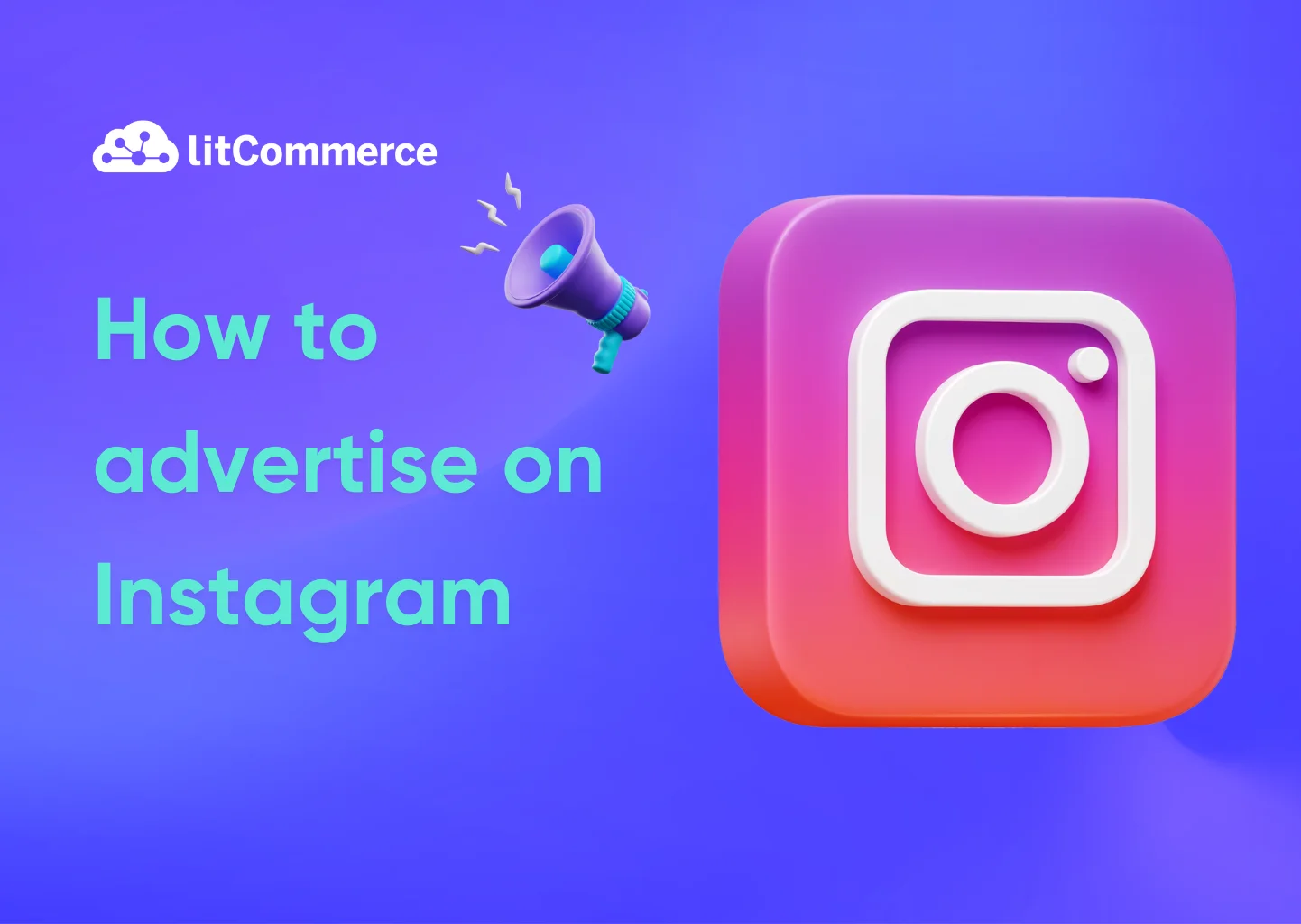Instagram isn’t just a social app—it’s an eCommerce powerhouse. In 2024 alone, over 130 million Instagram users tapped on a shopping post every month, and the platform generated more than $37 billion in eCommerce sales through its native shopping tools and ads. With Instagram Shopping, Reels ads, and AI-powered product discovery continuing to evolve, 2025 is shaping up to be the biggest year yet for online sellers.
Whether you’re launching a brand or scaling your DTC business, this masterclass will walk you through everything you need to know on how to advertise on Instagram—from formats and budgeting to advanced funnel strategies and optimization tips.
What Are Instagram Ads and How Do They Work?
Instagram ads are paid content placements that appear throughout the platform—on the Feed, Stories, Reels, Explore, and more. These ads look nearly identical to organic posts but are labeled as “Sponsored” and can include features like call-to-action buttons, product tags, and direct links.
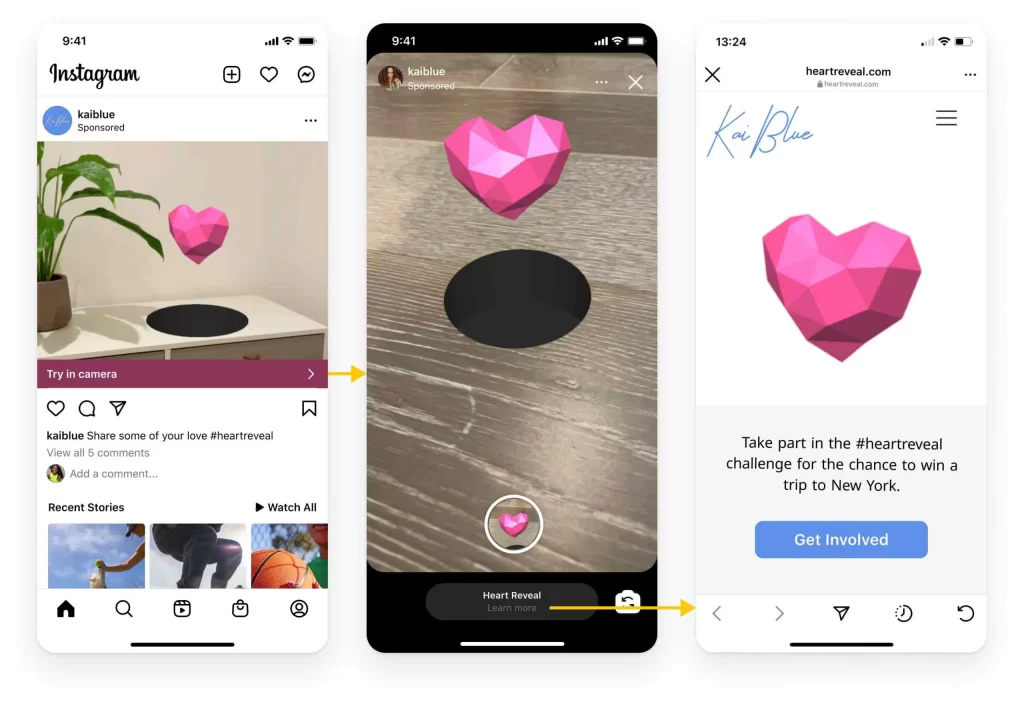
And how Instagram ads work? They’re managed through Meta Ads Manager, which gives advertisers full control over audience targeting, budget allocation, creative assets, and campaign objectives. You start by picking an ad objective—like getting website visits, sales, or engagement. Then, you choose who sees your ad based on location, interests, age, and more. Instagram offers several ad formats, including photo, video, Stories, Reels, and carousel ads.
You can also tag products for easy shopping. After that, you set your budget, and Meta’s system automatically places your ad where it’s most likely to perform well. Once the ad is live, you can track results like views, clicks, and conversions in real time to see what’s working and make improvements.
What makes Instagram ads powerful in 2025?
- AI-assisted targeting and dynamic creative optimization
- Seamless ecommerce integration with product catalogs and in-app checkout
- The rise of Reels ads, which now outperform traditional Feed ads in engagement and conversions
Whether your goal is to build brand awareness, drive traffic, or increase sales, learning how to advertise your business on Instagram can help at every stage of the funnel.
Instagram ads are especially effective for:
- Ecommerce brands looking to drive product sales through visual storytelling
- DTC businesses aiming to scale with multichannel reach
- Service providers and coaches using video and testimonials to build trust
- Content creators and influencers promoting merch or digital products
- Local businesses targeting users by location or interest
If your target audience is between 18 and 44, and your business benefits from visual content, Instagram advertising should be part of your growth strategy in 2025.
Quick Tip: Before investing in paid ads, make sure your organic strategy is working. Growing your audience organically helps you build trust, improve engagement, and lower your ad costs over time. If you need a game plan, check out this guide on how to get followers on Instagram — it breaks down actionable tactics to attract loyal, relevant followers in 2025.
Instagram Ad Types Explained
Diverse types of Instagram ads allow you to tell your brand story in creative ways across the entire user journey. Whether you’re showcasing a product, running a flash sale, or launching a new collection, there’s a format for every objective.
Single Image Ads
These are classic and effective—just one static image with your message, a strong call to action, and a clickable link. They appear in users’ Feeds and Stories, making them great for promotions, product launches, or seasonal sales.
Best for: Clean product shots, testimonials, flash deals
Pro tip: Use lifestyle imagery to spark emotion and context.
Cost benchmarks:
- Cost: CPC typically ranges from $0.50 to $2.00; CPM averages $6–$15; CPA for ecommerce is $8–$20.
- CTR: Healthy click-through rates are 0.8%–1.5% for image ads, though Reels and Stories may be higher.
- Technical specs:
| Element | Requirement/Recommendation |
|---|---|
| Image Size | 1080 x 1080 pixels (recommended) |
| Aspect Ratio | 1:1 (square); other ratios may be cropped |
| File Format | JPG or PNG |
| Max File Size | 30 MB |
| Caption Length | Up to 125 characters |
| Headline | Up to 40 characters |
| Hashtags | Up to 30 per ad |
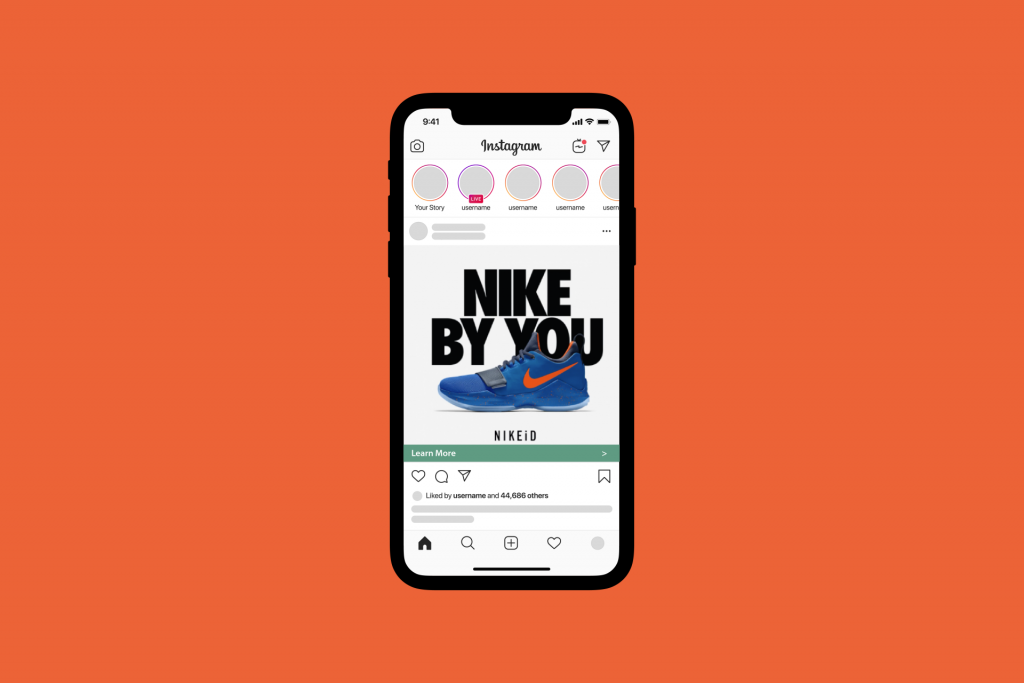
Video Ads
Video ads can be up to 60 seconds in the Feed or up to 15 seconds in Stories. In 2025, short-form video is dominating, and users are 2x more likely to engage with video than static content.
- Best for: Product demos, tutorials, behind-the-scenes clips
- Pro tip: Add subtitles—85% of Instagram videos are watched without sound.
- Cost benchmarks:
- CPC: $0.50–$2.00
- CPM: $6–$15
- CPA (ecommerce): $8–$20
- Healthy CTR: 0.8%–1.5% (higher for Reels/Stories)
- Technical specs:
| Placement | Aspect Ratio | Resolution | Max Duration | File Size | Formats |
|---|---|---|---|---|---|
| Feed | 4:5 (rec.) | ≥ 1080 x 1080 px | 1–60 seconds | 250 MB | MP4, MOV, GIF |
| Stories | 9:16 | 1080 x 1920 px | 1–15 seconds/card | 250 MB | MP4, MOV, GIF |
| Reels | 9:16 | ≥ 1080 x 1920 px | Up to 60 seconds | 4 GB | MP4, MOV |
| Carousel | 1:1 (feed), 9:16 (stories) | 1080 x 1080 px (feed), 1080 x 1920 px (stories) | Up to 60 sec (feed), 15 sec (stories) | 4 GB/video | MP4, MOV |
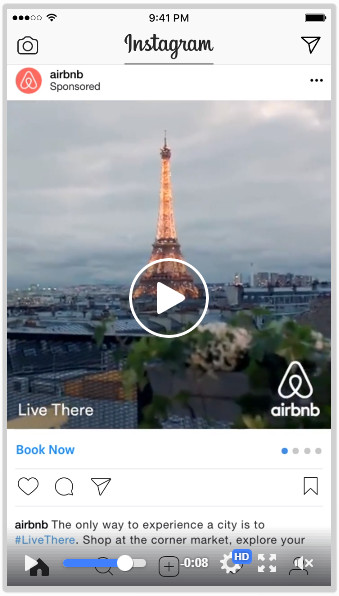
Stories Ads
Full-screen, vertical, and super engaging — that’s the magic of Stories ads. Want to know how to advertise on Instagram Stories? These ads appear between users’ Stories, making them perfect for time-sensitive offers or immersive brand moments. Instead of the old swipe-up feature, you now get link stickers, giving you even more creative control and flexibility to drive traffic.
- Best for: Limited-time offers, event promos, quick product highlights
- Pro tip: Use countdown stickers or polls to boost interaction.
- Costs Benchmarks
- CPM (Cost per 1,000 Impressions): ~$7.25
- CPC (Cost per Click): $0.50–$2.00
- CPA (Cost per Action): $8–$20 (ecommerce)
- CTR (Click-Through Rate): 0.8%–1.5%, often higher for Stories
- Technical Specs:
| Element | Requirement/Recommendation |
|---|---|
| Aspect Ratio | 9:16 (vertical) |
| Resolution | 1080 x 1920 pixels (minimum 600 x 1067 px accepted) |
| Image Format | JPG, PNG (max 30 MB) |
| Video Format | MP4, MOV (max 4 GB, recommended codecs: h.264, VP8) |
| Video Length | 1–15 seconds per card |
| Carousel | Up to 3 cards in Stories (images/videos, 15 sec max/card) |
| Safe Zones | Avoid placing text/logos in top/bottom 250 px |
| Captions | Not available as overlay—must be in the image/video file |
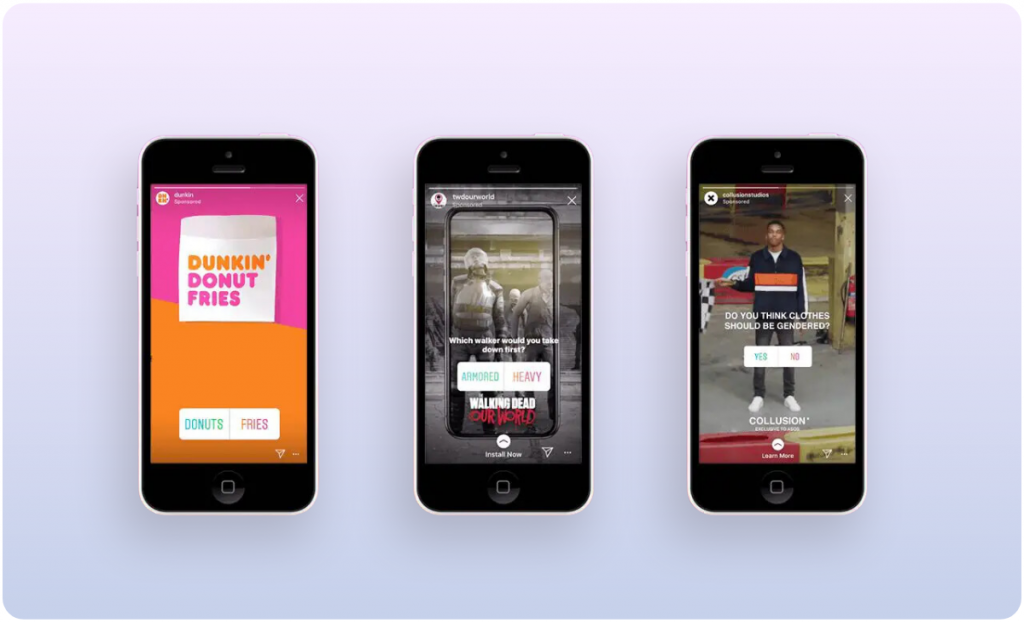
Reels Ads
Reels have quickly become the most engaging format on Instagram. These ads blend seamlessly with organic content and are shown to users who don’t follow you—ideal for top-of-funnel awareness.
- Best for: Trend-driven content, influencer collaborations, viral campaigns
- Pro tip:
- The first 3 seconds are critical—use visually striking openers, trending audio, or thought-provoking questions to stop the scroll.
- While Reels can now be up to 3 minutes, the algorithm prefers videos under 90 seconds. Most high-performing ads are 15–60 seconds.
- Use vertical (9:16) format, large readable text, and on-screen captions for accessibility
- Cost benchmarks:
- CPM (Cost per 1,000 Impressions): ~$4.29 (lower than Feed and Stories).
- CPC (Cost per Click): ~$1.21.
- CTR (Click-Through Rate): ~0.35% (organic engagement is higher, especially for well-optimized ads).
- Engagement Rate: 1.23% on average, outperforming other ad types.
- Conversion Rate: E-commerce brands see up to 35% higher conversion rates on Reels compared to other placements.
- Technical Specs:
| Feature | Requirement/Recommendation |
|---|---|
| Aspect Ratio | 9:16 (vertical) |
| Resolution | 1080 x 1920 px (minimum) |
| Length | Up to 3 minutes (sub-90 sec best) |
| File Size | Up to 4 GB |
| Formats | MP4, MOV |
| Captions | Strongly recommended |
| Audio | Use trending or brand-appropriate |
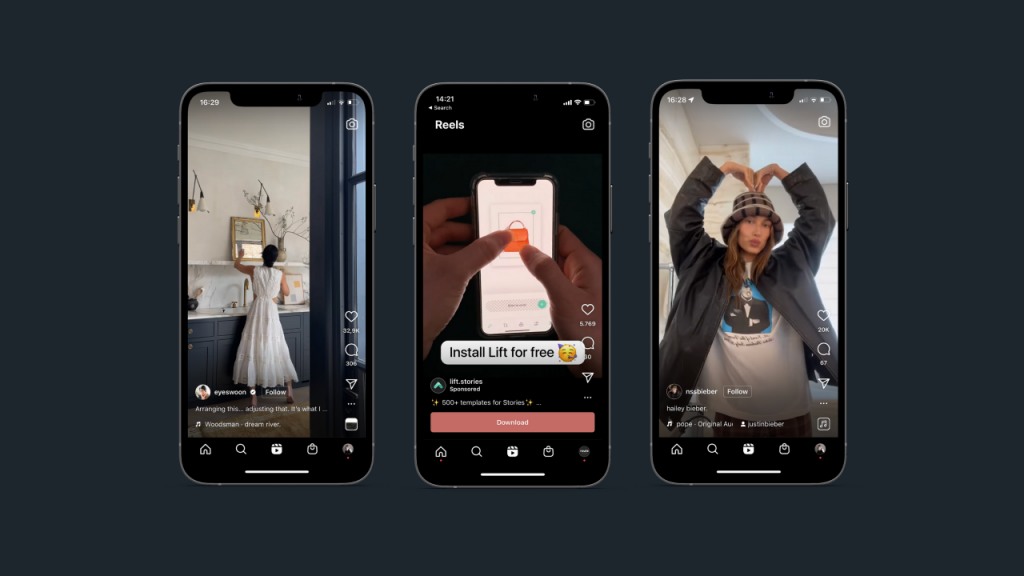
Carousel Ads
Instagram Carousel Ads are swipeable ad units that allow brands to showcase up to 10 images or videos within a single sponsored post. This format is highly effective for storytelling, product showcases, tutorials, and multi-feature explanations, offering both creative flexibility and strong engagement potential.
- Best for: Product showcases, multi-feature explanations, user-generated content
- Pro tip:
- Front-load value in the first 2 slides to reduce drop-off.
- Maintain a consistent theme or narrative across all slides for a polished, professional look.
- Combine images, videos, graphics, and text overlays to keep each slide engaging and varied
- Cost benchmarks:
- CPM (Cost per 1,000 Impressions): $6–$15
- CPC (Cost per Click): $0.50–$2.00
- CPA (Cost per Action): $8–$20 (ecommerce)
- CTR (Click-Through Rate): 0.8%–1.5% (often higher with strong creative)
- Technical specs:
| Placement | Cards per Ad | Aspect Ratio | Resolution | File Types | File Size | Video Duration |
|---|---|---|---|---|---|---|
| Feed | 2–10 | 1:1 (square) | 1080 x 1080 px | JPG, PNG, MP4, MOV | 30MB (image), 4GB (video) | 1–60 sec/slide710 |
| Stories | 2–3 | 9:16 (vertical) | 1080 x 1920 px | JPG, PNG, MP4, MOV | 30MB (image), 4GB (video) | Up to 15 sec/slide |

Collection Ads
Combines a cover image or video with product tiles pulled from your catalog. When clicked, users enter an immersive Instant Experience to browse and shop without leaving Instagram.
- Best for: Highlighting a full product line or themed collection.
- Pro tip: Use high-res imagery and tag products to streamline conversions.
- Cost benchmarks:
- CPM: $6–$15
- CPC: $0.50–$2.00
- CPA: $8–$20 (ecommerce average)
- AOV: Collection ads often yield higher average order value than single-image or video ads, due to the multi-product exposure
- Technical specs:
| Element | Requirement/Recommendation |
|---|---|
| Cover Image/Video | JPG, PNG, MP4, MOV, or GIF |
| Ratio | 1:1 (Feed); 9:16 (Reels/Stories) |
| Resolution | At least 1080 x 1080 px |
| Max Image File Size | 30 MB |
| Max Video File Size | 4 GB |
| Min Width/Height | 500 px |
| Headline | Up to 40 characters |
| Primary Text | Up to 125 characters |
| Product Tiles | Pulled from Instagram product catalog |
| Landing Page URL | Required |
| Instant Experience | Required (full-screen mobile page) |
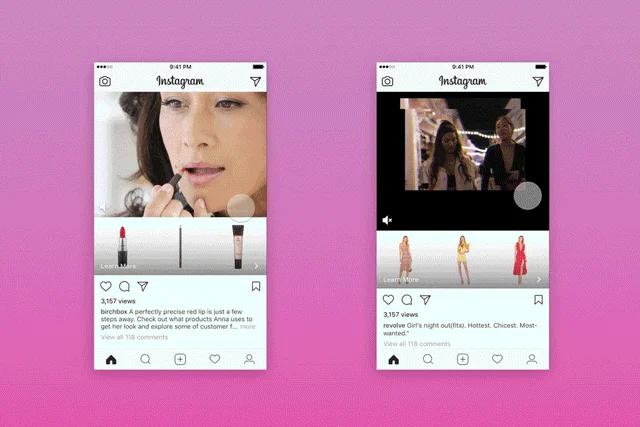
Explore Ads
These ads appear when users browse the Explore page—a great way to reach users based on interests and trending topics.
- Best for: Brand discovery, trend-based campaigns
- Pro tip: Use bold visuals to stand out in a highly visual environment.
- Cost benchmarks: Explore Ads typically have a CPM and CPC similar to Feed placements, averaging $6–$15 CPM and $0.50–$2.00 CPC, depending on audience and creative quality.
- Technical specs:
| Aspect | Recommendation |
|---|---|
| Image Ratio | 1:1 (square) or 4:5 (vertical) |
| Video Ratio | 1:1 (square), 4:5 (vertical), or 16:9 (landscape) |
| Resolution | At least 1080 x 1080 px |
| Video Length | Up to 60 seconds |
| File Types | JPG, PNG (images); MP4, MOV (videos) |
| File Size | Up to 30MB (image); up to 4GB (video) |
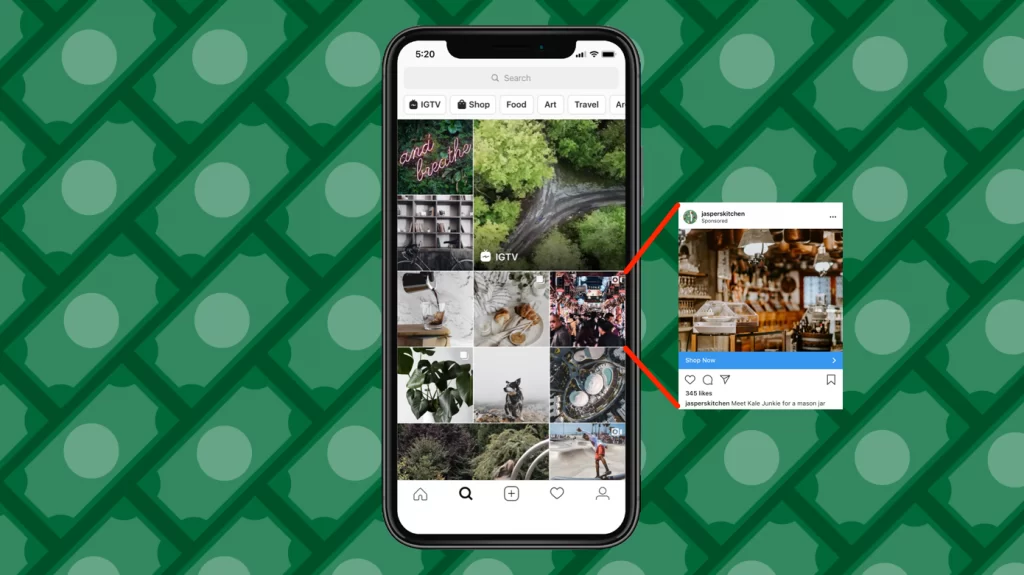
Instagram Shopping Ads
These ads are connected to your product catalog and allow users to tap and purchase directly within the app. With Instagram Checkout, you reduce friction and improve conversion rates.
Best for: Ecommerce brands with large inventories
Pro tip: Enable product tagging in all post formats for broader reach.
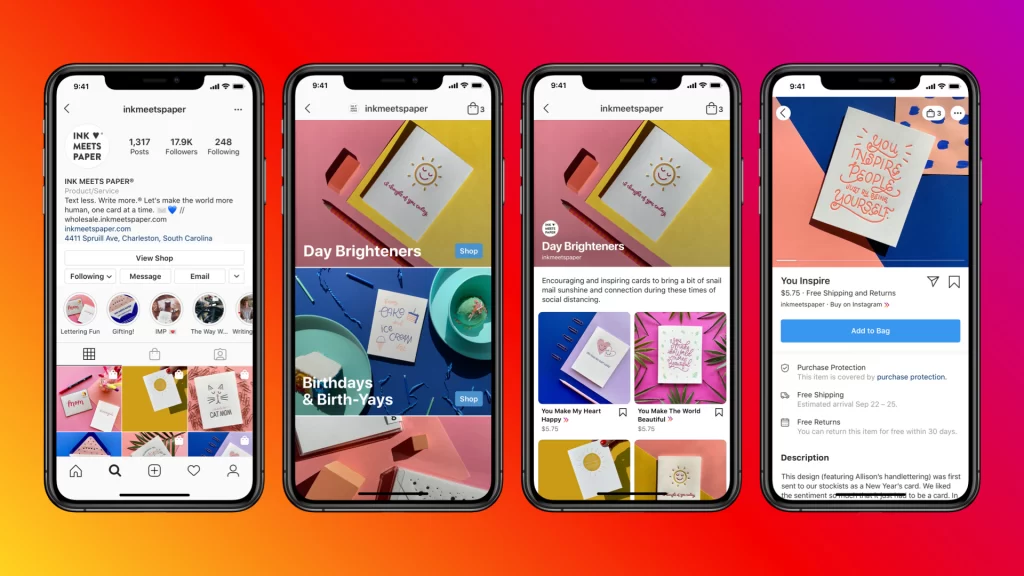
Ads with Reminders (New in 2025)
This new format lets users set reminders for upcoming product drops, sales, or events. When launch time hits, they get notified directly in the app.
- Best for: Dropshipping, product launches, timed offers
- Pro tip: Pair with countdown stories for double exposure.
- Technical specs:
| Placement | Format | Recommended Ratio | File Size | Notes |
|---|---|---|---|---|
| Feed, Stories | Image/Video/Carousel | 9:16 (Stories), 4:5 (Feed) | 30MB (image), 4GB (video) | Center text at top for dual placement |
| CTA | “Remind Me” | — | — | CTA is fixed for this ad type |
| Event Details | Name, Start/End Time | — | — | Localized to user’s timezone |
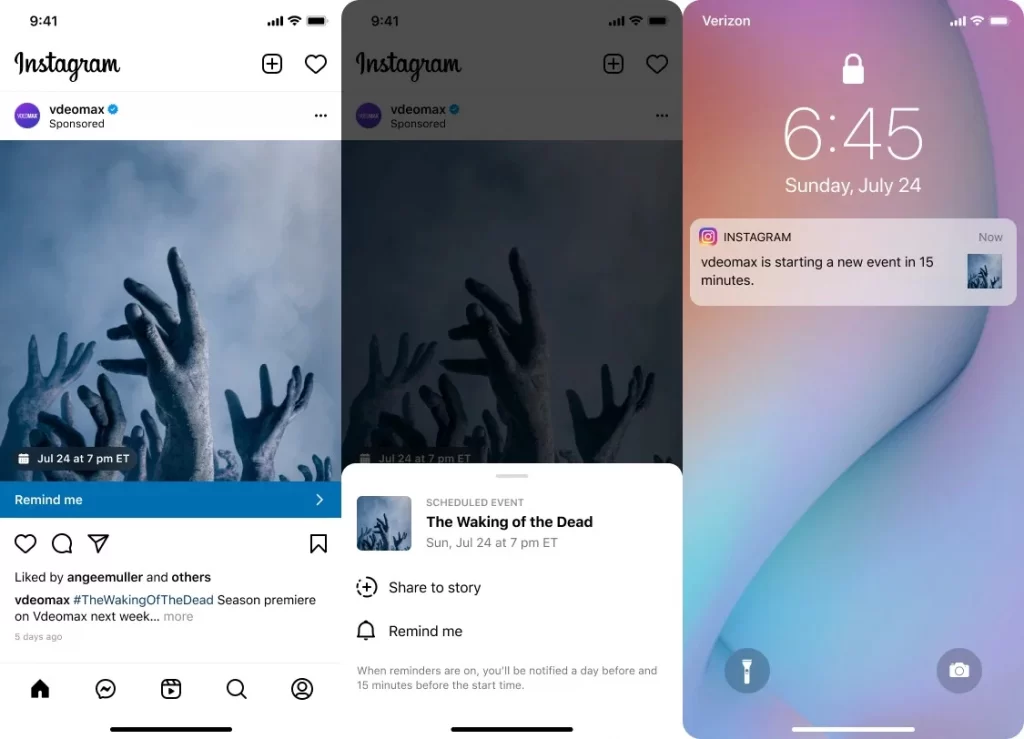
How Much Does It Cost to Advertise On Instagram?
Understanding the cost of Instagram advertising in 2025 is crucial to setting realistic goals and building profitable campaigns. The truth? Instagram ads don’t have a fixed price—the cost to advertise on Instagram varies based on your industry, audience, ad quality, and competition. That said, you can expect average ranges based on current data and trends.
Key Pricing Metrics to Know
- CPC (Cost per Click): Typically ranges from $0.50 to $2.00, depending on your niche and targeting.
- CPM (Cost per 1,000 Impressions): Averages between $6 and $15, though premium audiences (e.g., high-income shoppers) can cost more.
- CPA (Cost per Action): For ecommerce, expect around $8–$20 per purchase, depending on the product and funnel strength.
- CTR (Click-Through Rate): A healthy CTR in 2025 is 0.8% to 1.5%, but Reels and Stories ads often perform higher.
These numbers vary, but they give a reliable benchmark for planning your budget and tracking performance over time.
What Impacts the Cost of Your Campaign?
- Audience Targeting
Narrow, high-intent audiences usually cost more but drive better ROI. Broad audiences are cheaper but risk lower conversion rates. - Ad Placement
Reels and Stories tend to have lower CPCs than Feed ads, but carousel and collection ads can yield higher AOV (average order value). - Industry/Niche
- Fashion, beauty, and fitness: Moderate CPCs, high competition
- B2B SaaS or finance: Higher CPCs, lower CTRs
- DTC and ecommerce: Optimal balance for ROAS when done right
- Fashion, beauty, and fitness: Moderate CPCs, high competition
- Ad Quality & Engagement
Meta’s algorithm favors high-performing ads. If your content gets likes, saves, or comments, your costs go down over time (thanks to Relevance Score or Performance Ranking). - Campaign Objective
Awareness and traffic campaigns are cheaper; conversion-focused ads (e.g., purchases, leads) cost more but often bring higher ROI.
Budgeting Tips for 2025
- Test with $20–$50/day for a new audience or product
- Use Campaign Budget Optimization (CBO) to let Meta distribute spend to top performers
- Allocate more to retargeting—retargeted ads consistently yield 2–4x higher ROAS
- Scale gradually—increase budget in 20–30% increments to avoid performance drops
How to Run Ads on Instagram Using Meta Ads Manager
If you’re serious about Instagram advertising in 2025, Meta Ads Manager is where the magic happens. It’s Meta’s centralized platform for creating, managing, and optimizing ads across Instagram, Facebook, Messenger, and the Audience Network. It offers powerful targeting, placement control, and performance analytics you won’t get from just boosting posts.
Here’s how to make an Ad on Instagram 10 simple steps:
Step 1: Set up your Instagram Business Account
First things first—make sure your Instagram account is a Business or Creator profile and is connected to a Meta Business Manager. From your Business Manager dashboard, link your Instagram account under Business Settings > Accounts > Instagram Accounts.
Step 2: Create a new campaign
Next, head to Meta Ads Manager and click “Create”.
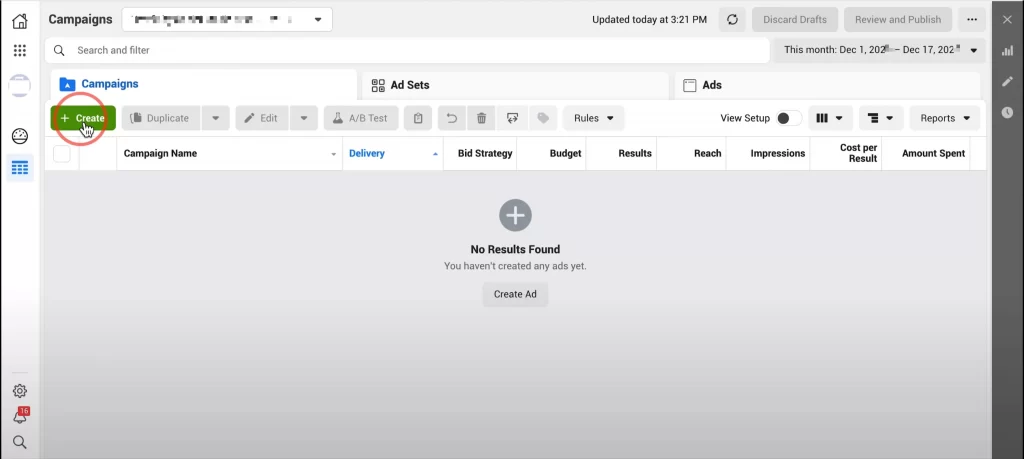
Choose your campaign objective based on your end goal (more on that below). Common objectives include:
1. Awareness
- Goal: Show your ad to as many people as possible.
- Brand Awareness: Increases recognition of your brand among individuals who are likely to recall it.
- Reach: Maximizes how many people see your ad within your chosen audience.
- Use it when: You’re launching a new product or just want more people to know your brand exists.
2. Traffic
- Goal: Send people to a destination like your website, app, or Messenger.
- Use it when: You want more visitors to your online store, blog, or landing page.
3. Engagement
- Goal: Get more interactions with your posts or Page.
- Post Engagement: Boost likes, shares, or comments.
- Page Likes: Increase followers for your Facebook Page.
- Event Responses: Promote events to drive RSVPs.
- Video Views: Get more people to watch your videos.
- Use it when: You want more activity on your posts or to build social proof.
4. Leads
- Goal: Collect leads through forms, phone calls, or messages.
- Instant Forms: Collect contact info without leaving Instagram.
- Calls: Get people to call your business directly.
- Messenger & WhatsApp: Start conversations to capture leads.
- Use it when: You want to grow your email list or get customer inquiries.
5. App Promotion
- Goal: Drive app installs and in-app activity.
- Use it when: You’ve got an app and want more people to download or use it.
6. Sales (Conversions)
- Goal: Get people to take a specific action like purchasing.
- Website Conversions: Track and increase actions like purchases, signups, or adds to cart.
- Catalog Sales (now called Advantage+ Shopping Campaigns): Promote products from your catalog with dynamic targeting.
- Shop Purchases: Drive sales directly from your Instagram or Facebook shop.
- Use it when: You’re focused on ROI — more sales, more conversions, more revenue.
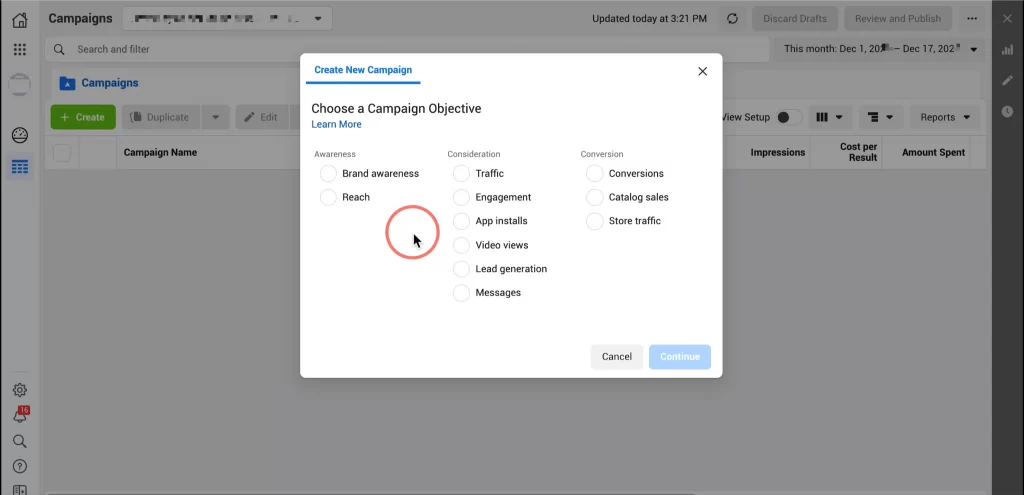
Step 3: Name your Ad
Once your audience and placements are set, proceed to the Ad creation stage. Here, you’ll select your Instagram account as the ad identity and choose your creative format: Single Image or Video, Carousel, or Collection.
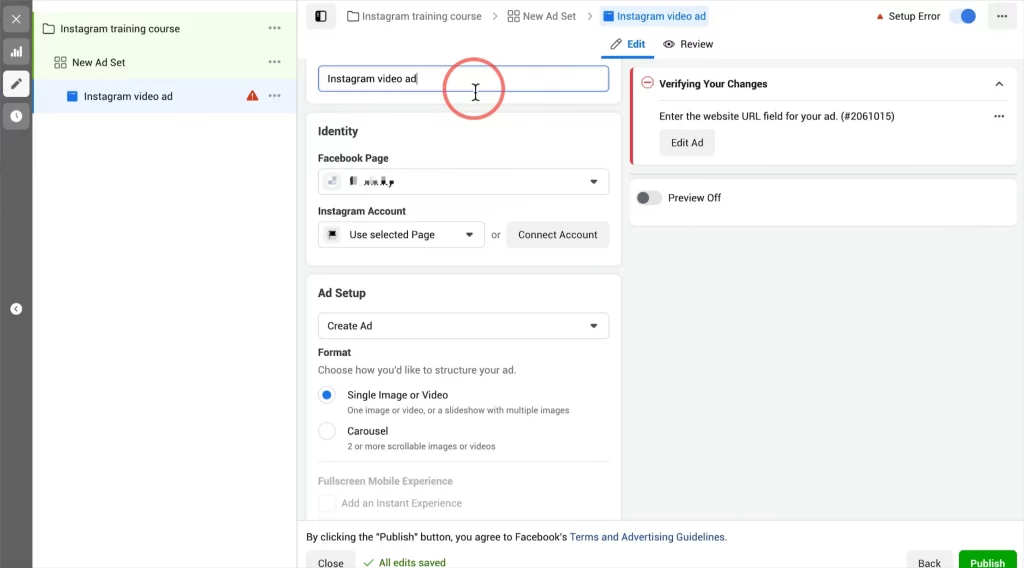
Step 4: Define your target audience
Next, you need to define your target audience by:
- Location (country, region, city)
- Age and gender
- Detailed interests and behaviors
- Custom Audiences (website visitors, email lists)
- Lookalike Audiences (similar to your best customers)
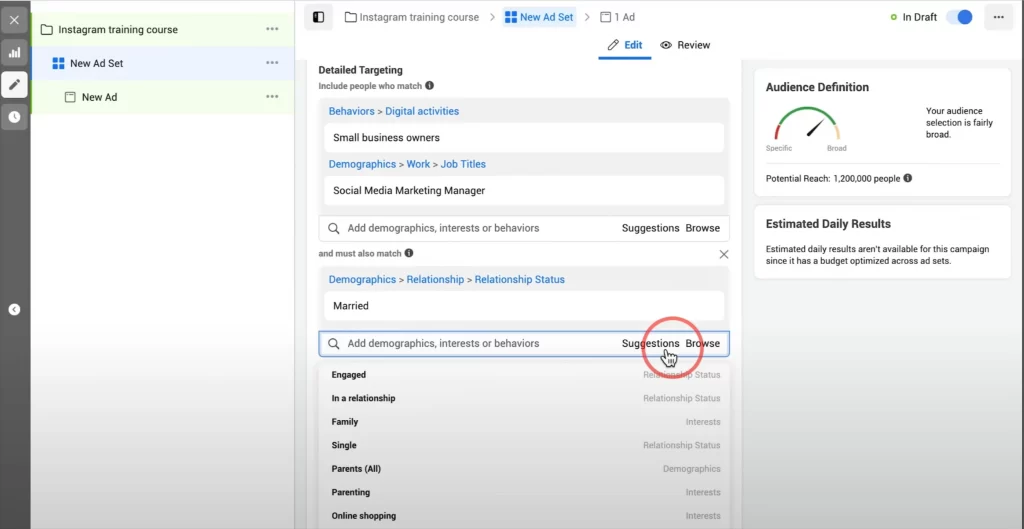
Placement: Choose Manual Placements and select Instagram-specific options:
- Feed
- Stories
- Reels
- Explore
(Optionally, Shopping Tab for e-commerce).
Step 5: Choose your placements
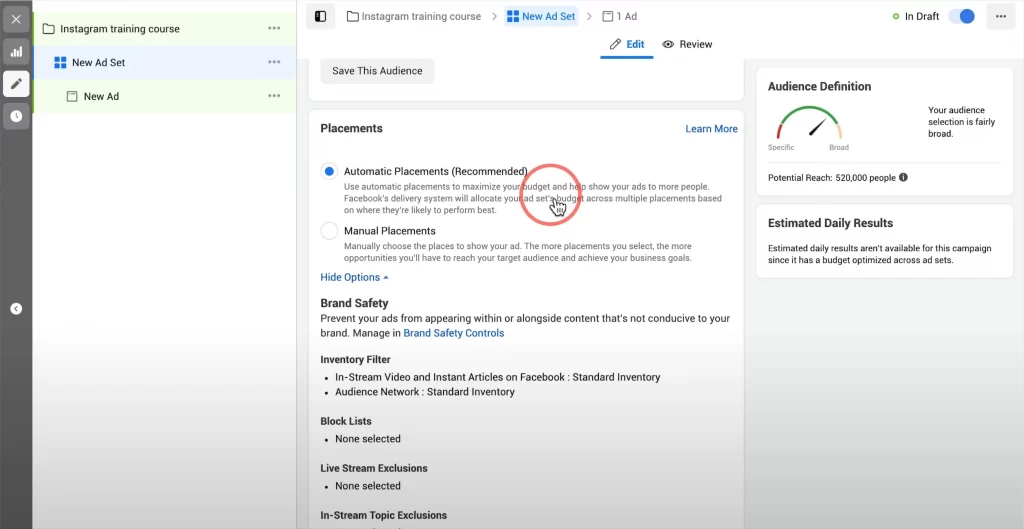
Go with Manual Placements if you only want to run on Instagram. After that, check the box next to Instagram in the Devices section.
Under the Placements section, you can choose your preferred destination for your ads. Recommended placements for Instagram include:
- Instagram Feed
- Instagram Stories
- Instagram Reels
- Explore
- Shopping Tab (if you’re product-based)
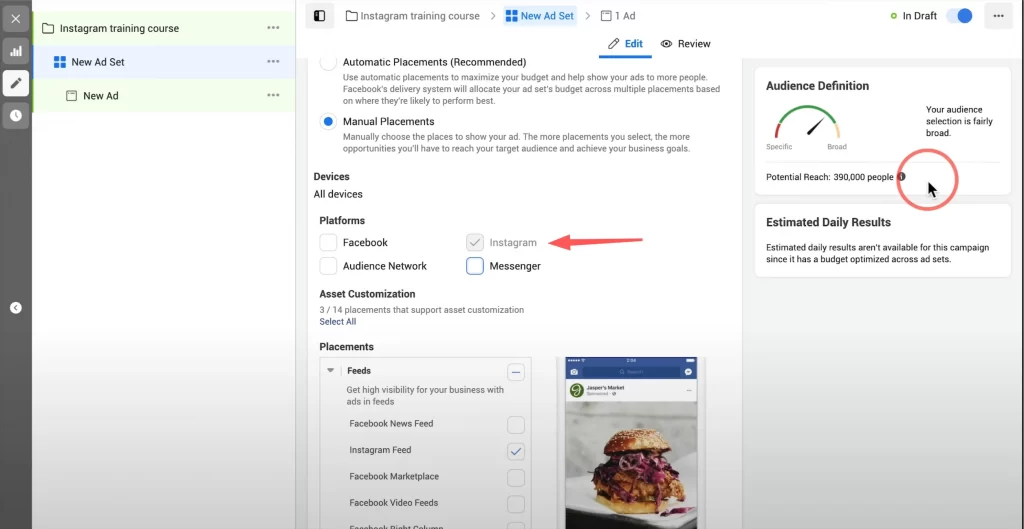
Step 6: Choose how your ads will be delivered
Now it’s time to optimize for Ad Delivery. This section allows you to tell Meta what type of results you want from your Instagram ads. Based on your selection, Meta’s algorithm will show your ads to people most likely to take that action — boosting your campaign’s performance.
1. Landing Page Views
- What it does: Delivers your ad to people most likely to click the link and wait for the landing page to fully load.
- When to use it: Best if you’re driving traffic to your site and want engaged users who’ll actually view your content, not just click and bounce.
2. Conversions
- What it does: Targets people likely to take valuable actions on your site (like purchases or sign-ups) — tracked via Meta Pixel.
- When to use it: Ideal when your goal is sales, sign-ups, or lead capture.
3. Link Clicks
- What it does: Optimizes for the highest number of clicks on your ad’s link, regardless of what happens after.
- When to use it: Useful for driving traffic, but not necessarily high-intent users.
4. Impressions
- What it does: Shows your ad as many times as possible to your audience.
- When to use it: Great for brand awareness or visibility campaigns.
5. Reach
- What it does: Maximizes the number of unique people who see your ad (avoids showing ads to the same people repeatedly).
- When to use it: Good for broad awareness across a wide audience.
6. Engagement
- What it does: Prioritizes delivery to people likely to like, comment, or share your ad.
- When to use it: If you want to boost post interaction or build social proof.
7. Video Views
- What it does: Targets users who are more likely to watch your video ad.
- When to use it: Ideal for storytelling, branding, or showcasing product features.
8. App Installs
- What it does: Optimizes ad delivery to people who are likely to install your app.
- When to use it: Perfect for mobile app promotion campaigns.
9. Lead Generation
- What it does: Shows your ad to people likely to fill out lead forms (like name, email, phone number).
- When to use it: Best for gathering contacts for follow-up or sales.
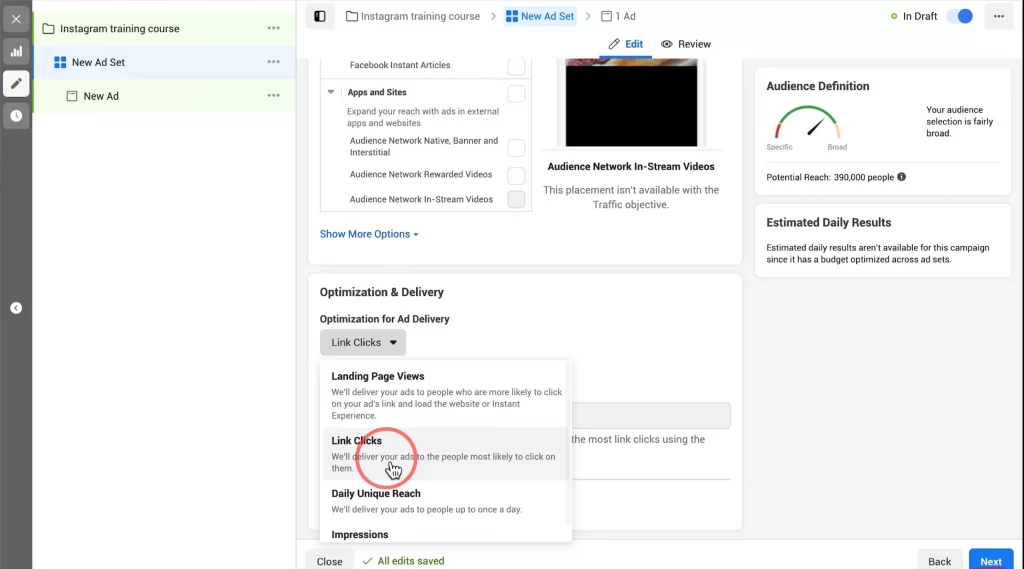
Upload your visuals, write your primary text, headline, description, and CTA button (e.g., Shop Now, Learn More, Sign Up).
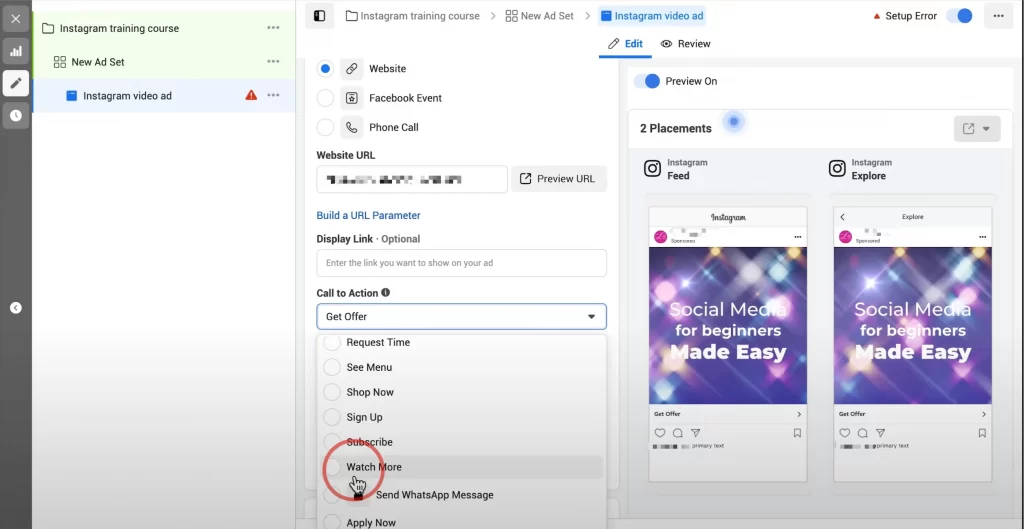
Step 7: Review and publish
Double-check everything—audience, ad preview, budget, placement. When ready, click “Publish” and your ad goes into review. Approval usually takes a few hours.
How to Advertise on Instagram: Performance Tracking
Launching an Instagram ad is just the beginning—knowing what’s working (and what’s not) is where the real ROI lives. With powerful tools from Meta and third-party integrations, 2025 makes it easier than ever to track every click, view, and conversion.
Key metrics to track
Here are the core metrics every Instagram advertiser should monitor:
- CTR (Click-Through Rate) – Measures how many people clicked your ad after seeing it. A healthy CTR is usually 0.8%–1.5%.
- CPA (Cost Per Acquisition) – How much you’re paying per sale, lead, or desired action.
- ROAS (Return on Ad Spend) – The gold standard: if you spend $100 and earn $400, your ROAS is 4.0.
- Conversion Rate – What percentage of viewers actually complete your goal (purchase, sign-up, etc.).
- Impressions & Reach – How many people saw your ad and how often.
- Frequency – Average times your ad was shown per user (watch for ad fatigue if this creeps above 3–4).
Using meta Ads manager for performance insights
Meta Ads Manager is your go-to for real-time reporting. Here’s what you can do:
- Break down performance by placement (e.g., Reels vs. Stories vs. Feed)
- Compare audience segments (cold vs. warm traffic)
- Track purchases, adds to cart, and checkouts (with Meta Pixel installed)
- Run A/B tests on creatives, CTAs, and audience groups
Pro Tip: Use custom columns in Ads Manager to build views tailored to your KPIs—especially helpful for ecommerce ROAS tracking.
Third-party tools to deepen insights
While Meta Ads Manager is powerful, layering in additional tools gives you deeper control:
- Google Analytics 4 (GA4) – For cross-channel attribution, bounce rates, time on page
- Shopify + Meta integration – Native reporting on purchase behavior from ad click to checkout
- Klaviyo – Track how Instagram ads feed into email flows and repeat purchases
- Triple Whale or Northbeam – Attribution dashboards built for ecommerce brands
Final Tip: The best-performing brands in 2025 aren’t just creative—they’re data-driven. Measure early, test often, and optimize relentlessly.
Instagram Ad Trends to Watch in 2025
Staying ahead of the curve is what separates average advertisers from elite performers. Instagram is constantly evolving, and in 2025, it’s leaning harder into AI, interactivity, and immersive ecommerce. These are the top trends you need to be tracking right now.
1. Short-form video still reigns
Reels are the #1 ad format for engagement in 2025. Instagram’s algorithm continues to push short-form, vertical video—especially when it mimics native, organic content.
- UGC-style Reels drive up to 40% higher click-through rates than polished studio ads.
- Use TikTok-style trends with intention—don’t just copy; remix to match your brand voice.
2. Shoppable reels & live shopping
Instagram continues its push toward in-app shopping. Reels with product tags, “tap to buy” overlays, and Live Shopping events are seeing massive uptake—especially for DTC brands.
- Integrate your Shopify or BigCommerce catalog with Instagram Shopping
- Tag products in Reels, Stories, and even carousel posts
- Expect increased visibility for shops with active product tagging
3. Meta Advantage+ automation
Meta is going all-in on automation. Expect more businesses to switch to Advantage+ Shopping Campaigns (ASC), which use AI to handle:
- Budget optimization
- Creative rotation
- Audience targeting
Pro users are seeing 20–30% lower CPAs by letting the algorithm take over—with light manual oversight.
4. Micro-influencer collabs go mainstream
Smaller influencers with 10k–100k followers are driving outsized results on Instagram thanks to high engagement and trust.
- Use influencer content as ad creative (spark ads-style)
- Whitelist creators to run dark posts from their profiles
- Blend UGC with paid for native-style reach
5. Interactive ad elements
Expect to see more:
- Polls and quizzes in Stories ads
- Reminder ads for product drops or events
- Clickable Reels overlays with multiple CTA options
These increase time-on-ad and reduce bounce—helping the algorithm favor your campaign.
Final Thoughts: Is Instagram Advertising Worth It in 2025?
Instagram isn’t just still relevant in 2025—it’s a critical part of a high-performing digital marketing stack. With advanced AI tools, immersive shopping features, and short-form video dominance, advertising with Instagram arguably one of the most effective way for eCommerce growth today.
Who Should Invest in Instagram Ads?
✅ Ecommerce and DTC brands looking to scale product sales
✅ Creators and solopreneurs building digital products or services
✅ Retailers seeking multichannel exposure across Instagram, Facebook, and WhatsApp
✅ Brands targeting Millennials or Gen Z with visual-first messaging
If your audience is on Instagram—and you can tell a compelling visual story—you should be running ads. Period.
When to Consider Other Channels
❌ You’re targeting a niche B2B audience → try LinkedIn
❌ Your content is heavy on long-form education → consider YouTube
❌ Your products go viral with lo-fi video → test TikTok alongside Instagram
Instagram is powerful—but it’s not a one-size-fits-all. The most effective strategy is often an integrated one: Instagram for demand creation, TikTok for virality, Facebook for retargeting, and email/SMS for conversion.
If you’re ready to take your Instagram marketing to the next level, don’t miss out on our Instagram Feed Management Tool. It’s designed to help online sellers like you easily organize, optimize, and sync your product feeds directly to Instagram. Whether you’re running ads or simply showcasing your products through posts and stories, this tool makes your catalog more discoverable and shoppable. Check it out to streamline your Instagram selling process and boost your sales with less hassle!

